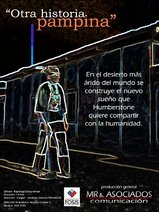domingo, octubre 21, 2007
TRAILER DE CORTOMETRAJE "SANTA MARIA HISTORIA Y LEYENDA".
domingo, septiembre 09, 2007
Tim Leary, Internet y Vicente.
lunes, septiembre 03, 2007
Todos Invitados a Alterar el Orden
martes, agosto 07, 2007
miércoles, julio 25, 2007
miércoles, julio 18, 2007
LA TIRANA 2007 "Misa 16 de Julio"
El origen de esta fiesta se remonta al año 1535, cuando según la leyenda, Diego de Almagro en su recorrido hacia el descubrimiento de Chile desde Cuzco llevaba en su comitiva a un príncipe incaico cautivo llamado Huillac Huma y que era el último sacerdote del culto a Inti. Junto a él, iba su bella hija llamada Ñusta Huillac.
Cuando el ejército se encontraba cerca del actual pueblo de Pica, muchos de los prisioneros incas huyeron hacia la pampa del Tamarugal, entre ellos, Ñusta Huillac y su padre. Refugiados en los bosques de tamarugos, Ñusta Huillac organizó una rebelión para reestablecer el poder de su nación, llegando a ser temida tanto por sus enemigos que la nombraron como la "Tirana del Tamarugal".
Un día llegó un joven expedicionario portugués llamado Vasco de Almeida que había perdido su ruta hacia la mítica "Mina del Sol". El flechazo entre la bella reina y el hispano fue inmediato. Cuando su relación fue descubierta, fueron condenados a muerte ambos. Almeida, como una forma de que su amor sea eterno, convence a Ñusta Huillac para que se bautice y así tras la muerte, renacerían en el más allá y vivirían unidos para siempre. Ambos son descubiertos en la ceremonia y son asesinados por los nativos.
Años después, y como forma de homenajear a estos jóvenes, fue fundada una iglesia que se conserva en la actualidad bajo el nombre de "Nuestra Señora del Carmen de La Tirana".
Al llegar al pueblo, todas las hermandades religiosas danzantes inician sus homenajes, de a una a través de un saludo en el mismo lugar conocido como "El Calvario". Así, el protocolo religioso de la fiesta continúa en el templo, con los tradicionales cantos y danzas, saludos y procesiones. En el templo lo primero es el saludo a la ermita de la virgen. En forma individual o en grupos pequeños, los peregrinos realizan diversos sacrificios para cumplir con sus mandas o peticiones, siendo las más populares la de llegar al santuario arrastrándose o arrodillados.
Esta fiesta corresponde a una de las principales representantes del folclore chileno, pues aún conserva la característica principal, definitoria del concepto, al constituir una tradición vigente, que se ha transmitido de generación en generación.
"Virgen del Carmen", " La Chinita"....una fiesta religiosa popular y grande de Chile, un aporte de la disco club Crbro.....
"Virgin of the Carmen", "the Chinita"....una popular and great religious celebration of Chile, a contribution of the disc Crbro club.....
viernes, julio 06, 2007
jueves, julio 05, 2007
viernes, junio 29, 2007
A 100 años de la matanza de la escuela Santa Maria
Recreacion historica de la masacre de obreros salitreros ocurrida el 21 de Diciembre de 1907, hace un siglo, en la Escuela Santa Maria de Iquique, Chile. Collage audiovisual hecho con fragmentos de peliculas y fotografias paneadas de la epoca.
Traile de la Obra Realizada por el Sr. Mario Santander Albornoz, quien vivio en las salitreras en el auge del Oro blanco, trabajó más de treinta años en las minas de la pampa salitrera, en las ex.Oficinas Alianza y Victoria y después del cierre de la Of.Victoria en Maria Elena donde trabajó hasta 1983, año de su jubilación.
Su gran interés por todo lo que sea pampino y por repudiar todo lo que signifique explotacion injusta de los trabajadores. Ademas en los años 1995-96 escribó dos libros publicados por la Editorial KIER de Buenoa Aires, Argentina, pero no sobre temas pampinos, sino cientifico-espirituales.
tiene tres portales en Interner: "Oficina Victoria", "Esociencia" y "Tiempos de Cambio", este último para incentivar a la juventud a buscar las ideas-fuerza convertidas en acción, que permitan renovar el actual paradigma neoliberal productor de todas las injusticias que hoy sufre la humanidad.
http://groups.msn.com/OficinaVICTORIA
http://groups.msn.com/Esociencia
http://groups.msn.com/TIEMPOSdeCAMBIO
sábado, junio 23, 2007
Luz de Camiña - Light of Camiña
Camiña tiene un total de 269 habitantes. De origen prehispano y con una importante población aborigen. Era el centro del repartimiento colonial que incluía el valle de Tana, Sotoca y hasta la frontera con Isluga.
La construcción de las viviendas es de adobe, mientras que su iglesia cercana a la plaza posee un portal construido en el siglo XVIII.
The commune of Camiña is located in the most northern sector of the province of Iquique. The access to the valley is made through route A-5 to 147 kilometers of Iquique, later to branch off itself towards the east by a mixed way of 32 kilometers. It has an extension of 37 kilometers and its main hydric resource is the river Camiña or Tana, whose origin is in the Pumire Hill and its passage extends until the Pacific Ocean. Camiña has a total of 269 inhabitants. Of Hispanic origin and with an important native population. It was the center of the colonial repartimiento that included the valley of Tana, Sotoca and until the border with Isluga. The construction of the houses is of marinates, whereas its church near the seat has a vestibule constructed in century XVIII.
miércoles, junio 20, 2007
CHICO E' LAS CONCHA. HA! TIK, TAK!!
domingo, mayo 06, 2007
CALATAMBO ALBARRACÍN "CALICHE" Cueca
Catalambo Albarracín, autor, compositor y folklorista que ha dedicado gran parte de sus esfuerzos a rescatar la música nortina chilena. Fue criado en un campamento salitrero y desde joven se empeñó en dar a conocer la música de su tierra Según el testimonio del folclorista chileno Calatambo Albarracín (1924) estas fiestas transcurrían en términos musicales entre algunas cuecas campesinas traídas en las maletas de los "enganchados sureños", los valses peruanos que rememoraban de algún modo la soberanía de ese país en estas pampas, y la música de pequeños grupos que interpretaban instrumentos de vientos. Me refiero a los aymaras que trabajan en la extracción del salitre. El hombre andino, con zampoñas y sicuris se conecta con los Mallkus o la Pachamama. Al igual que los chinos, los aymaras, eran los grupos marginados y sobre todo discriminados por el resto de la sociedad, incluso por los mismos trabajadores. El folclorista ya citado, menciona que todo el mundo bailaba y cantaba los valses peruanos. Sólo de vez en cuando, un campesino, golpeaba la mesa y empezaba a payar recordando sus paisajes de su tierra natal. Era como una postal llena de árboles, vasijas de barro, en plena pampa. Hay que agregar además que en la pampa salitrera del norte grande, tanto los bolivianos como los peruanos, también celebraban sus fiestas patrias. En ese espacio, todas las nacionalidades, recordaban, por lo menos por un rato, sus patrias.
Catalambo Albarracín, author, composer and folklorista that great part of its efforts has dedicated to rescue Chilean nortina music. He was bred in a salitrero camping and from young person one insisted on presenting music his earth According to the testimony of the Chilean folclorista Calatambo Albarracín (1924) these celebrations passed in musical terms between some cuecas farmers brought in the hooked suitcases of the "sureños ones", valses Peruvian that recalled of some way the sovereignty of that country in these Pampas, and the music of small groups that interpreted wind instruments. I talk about aymaras that they work in the extraction of the saltpeter. The Andean man, with zampoñas and sicuris connects with the Mallkus or the Pachamama. Like the Chinese, aymaras, were the marginalized groups and mainly discriminated by the rest of the society, even by such workers. The folclorista already mentioned, mentions that everybody danced and sang valses Peruvian. Only once in a while, a farmer, struck the table and began to payar remembering his landscapes of his native earth. He was like a postal flood of trees, vasijas of mud, in the heat of Pampas. It is necessary to add in addition that in salitrera Pampas of the great north, as much the Bolivians as the Peruvians, also celebrated their celebrations mother countries. In that space, all the nationalities, remembered, at least by awhile, their mother countries.
jueves, mayo 03, 2007
REINA DEL TAMARUGAL
"Virgen del Carmen", " La Chinita"....una fiesta religiosa popular y grande de Chile, un aporte de la disco club Crbro.....
"Virgin of the Carmen", "the Chinita"....una popular and great religious celebration of Chile, a contribution of the disc Crbro club.....
La Virgen de La Tirana es conocida en todo el mundo cristiano. Con su mensaje atravesó los mares y cruzó las montañas. En países muy lejanos se escucha hablar de leyendas. De un pueblo, donde el desierto florece perdido en la soledad y que a mediados de Julio, con un sol de primavera, se junta para danzar a su reina: “La Tirana”, la Virgen del Desierto. Y cuenta la gente que baja de la cordillera y sube del mar, y llegan a ver la imagen de la Virgen quedan impactados, encandilados por esos ojos negros que brillarán en sus almas para siempre. Esa Virgen del desierto que protege al caminante, auxilia a ese que sufre, da luz a los que no ven, que su senda es el camino y su mirada la luz. Y son esos caminantes que hasta sus plantas se arrastran con la sencillez del humilde y la bondad de quien ama bien. Ella los comprende y con su hábito milagroso calma todas las tristezas y envuelve las amarguras con su manto de amor que cubre toda su tierra. The Virgin of the Tyrant is well-known anywhere in the world Christian. With his message she crossed the seas and she crossed mountains. In very distant countries she is listened to speak of legend. Of a town, where the desert blooms lost in the solitude and that in the middle of Julio, with a spring sun, is joined to dance to its queen: “La Tirana”, the Virgin of the Desert. And the people count who lower of the mountain range and raise of the sea, and get to see the image of the Virgin are hit, excited by those black eyes that will shine in their souls for always. That Virgin of the desert that protects the traveller, helps to whom suffers, gives to light to which do not see, that its footpath is the way and its glance the light. And they are those travellers who until their plants crawl with the simplicity of the humble one and the kindness of that it loves well. It understands and with her miraculous habit calm all the sadnesses and surrounds the bitterness with her mantle of love that covers all its earth.jueves, abril 12, 2007
Demo Documental "San Carlos Carnaval"
Este Docu nace a fines del verano de 2000 cuando realizaba funciones de Reportero Gráfico en un medio local, un tema que me llamaba mucho al atención por la forma de dar termino a un verano y eso me hacia ebocar momentos de mi infancia,esos años cuando era un niño mis padres nos preparaban para ir a observar esta fiesta urbana que para mi era algo muy extraño y freak e inocentemente me preguntaba... ¿por que el mono? ¿tanto copete? ¿y por que lo queman? ¿un tipo vestido de negro que grita y canta? tantas interrogantes dentro de mi mente infantil. Este verano e vivido algo mucho mas profundo en cuanto al tema del carnaval, por que fuy parte en un mes ser un verdadero san carlino y descubrir que gente todavia independiente y organizadamente trata de preservar esta fiesta que siempre a sido y será Iquiqueña. Fiesta unica en el Mundo y que se llama "San Carlos Carnaval". mas informacion www.sancarloscarnaval.blogspot.com
This Docu is born by the end of the summer of 2000 when it made functions of Graphical Reporter in the average premises, a subject that called much to me to the attention by the form to give I finish to a summer and that me towards ebocar moments of my childhood, those years when he was a boy my parents prepared to us to go to observe this urban celebration that stops my was something very strange and freak and innocently asked to me... so that the monkey? as much copete? and so that they burn it? a type dressed black that shouts and sings? so many questions within infantile my mennte. This summer and lived something but much deep as far as the subject of the carnival, so that fuy part in a month to be true san carlino and to discover that independent people todavia and organizadamente try to preserve this celebration that always to be and will be Iquiqueña. Unica celebration in the World and that is called "San Carlos Carnival".
more info www.sancarloscarnaval.blogspot.commiércoles, abril 04, 2007
domingo, marzo 11, 2007
jueves, marzo 01, 2007
martes, febrero 27, 2007
Paintmarvel Dibujos de Adolfo Torino
jueves, febrero 15, 2007
Carnaval de barrio "San Carlos"













